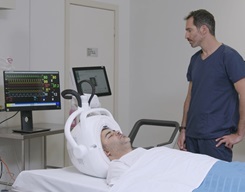
EMVision has announced “exceptional results” with what the company claims is a world-first neurodiagnostic technology for identifying stroke and stroke types.
These results come from the EMView trial, in which a total of 307 participants were enrolled and successfully scanned with EMVision’s Emu brain scanner across three Australian centres: Liverpool Hospital (Liverpool, Australia), Royal Melbourne Hospital (Parkville, Australia) and Princess Alexandra Hospital (Brisbane, Australia). This population included 277 suspected stroke patients, with 48 haemorrhagic and 140 ischaemic strokes being confirmed.
“The results are very encouraging, particularly as related to detection capabilities and sensitivity to small haemorrhages,” said Australian Stroke Alliance co-chairs Geoffrey Donnan (University of Melbourne, Melbourne, Australia) and Stephen Davis (Royal Melbourne Hospital, Parkville, Australia). “We look forward to confirmation of this impressive neurodiagnostic capability in the validation trial.”
The EMView study’s primary objective of collecting matched Emu brain scans and patient computed tomography/magnetic resonance imaging (CT/MRI) brain scans, for the advancement of the scanner’s artificial intelligence (AI)-based diagnostic ‘blood or not’ and ‘clot or not’ algorithms, was ultimately achieved.
To train the AI algorithms, scan data from more than 240 participants were used—including confirmed haemorrhagic and ischaemic strokes, a variety of common stroke mimics, and healthy volunteer scans. This enabled the algorithm to learn patterns and features associated with a normal versus abnormal brain, such as hyperacute, acute, subacute and chronic ischaemic and haemorrhagic stroke. The training set was diverse, with varied cases—across different demographics, stroke sizes and locations, and time from onset—being used to enhance the model’s generalisability.
The neurodiagnostic AI algorithms were then applied to a test dataset that was isolated and not used in the training. According to EMVision, this prevented the model from ‘learning’ any patterns from the test data, ensuring the assessment provided a real-world evaluation with “truly unseen cases”—albeit on a smaller sample size compared to the company’s upcoming, pivotal validation trial, which intends to produce “definitive sensitivity/specificity confirmation”.
Regarding the EMView study’s ‘blood or not’ detection and classification results, EMVision’s recent press release details that 12 out of 13 haemorrhagic test cases were correctly identified (92% sensitivity), while 47 out of 55 non-haemorrhagic test cases were correctly identified (85% specificity). In addition, the study’s ‘clot or not’ detection and classification results revealed that 17 out of 20 ischaemic test cases were correctly identified (85% sensitivity), and 25 out of 32 non-ischaemic test cases were correctly identified (78% specificity).
EMVision further claims that the AI model demonstrated improving recognition of a wide range of anomalies with additional clinical training data, resulting in steady performance improvements. The company’s release adds that meaningful performance gains are observed as more data are added, indicating the AI model’s scalability to continue improvement with expanded data—and, following this exercise, the isolated test data are then added into the complete training dataset.
The results of this multi-site study with the point-of-care Emu brain scanner will be submitted for publication following peer review.
Additionally, with these positive and “promising” study results, EMVision says it is set to move forward as planned with a validation trial in which the company will firmly establish the diagnostic capabilities of its portable brain scanner to support US Food and Drug Administration (FDA) de novo clearance and product commercialisation. EMVision is expecting to recruit up to 300 suspected stroke patients across a minimum of three USA-based centres and two domestic stroke centres in Australia, and estimates that the validation trial’s duration will be between six and 12 months. The company says it has site visits scheduled with its prospective US luminary investigational sites in November 2024.
“There is a huge unmet need for stroke and stroke type diagnosis at the point of care,” said EMVision chief executive officer (CEO) Scott Kirkland. “We can fill that need. We are very proud of these results, which highlight our technology’s unique neurodiagnostic capabilities. We remain focused on progressing and executing our clinical validation and commercialisation strategy as we look to revolutionise stroke diagnosis, and make a substantial positive impact on one of the major causes of global disability.”









